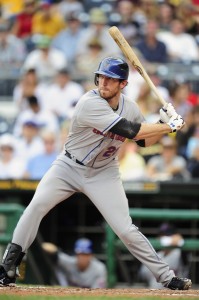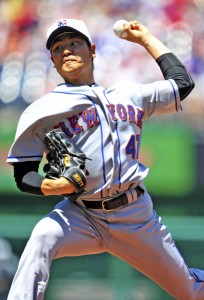On the Bright Side

The 2010 season was far from a total disaster for the Mets. The team won 79 games, up from 70 the year before. David Wright and Jose Reyes rebounded from disappointing seasons marred by injury. Mike Pelfrey won 15 games and established himself as a solid starter. Unheralded outfielder Angel Pagan and pitcher R.A. Dickey enjoyed surprising success that they have a good chance of repeating. The Mets had their best rookie crop in years, with Ike Davis, Jonathon Niese, Hisanori Takahashi, Josh Thole and Ruben Tejada becoming key components of the team. Overall, the Mets managed to stay a lot healthier, losing about 900 games to the disabled list in 2010 compared to about 1500 games in 2009.
Their Downfall
But the improved health also exposed the limits of Omar Minaya’s roster and left Jerry Manuel without excuses for his questionable moves. In 2009, management seemed to be waiting for all the injured players to return in 2010. When Carlos Beltran returned this past July after missing the entire first half, the Mets finally had all their stars back. When Luis Castillo returned a few days later, the Mets had their starting lineup intact for the first time since May ’09. But the Mets, who had finished the first half 48-40, began the second half by losing nine of eleven. The Mets scored only 13 runs in those nine losses.
Far from sparking the team, Beltran hit just .204 with one homer in 54 July at-bats. Castillo hit .214 in 42 July at-bats with an OPS of .545. But what made matters worse was Manuel’s insistence on batting Castillo second and Beltran cleanup much of the time.
Manuel also rushed Jose Reyes back from an oblique injury that Reyes suffered in late June. Before getting hurt, Reyes looked to have regained his All-Star form at bat, on the bases and in the field. His June OPS was .893. Reyes did not come near that mark the rest of the way.
Injuries Again
In the latter part of the season, the Mets suffered some significant injuries, but they did not affect the team’s fall from contention. Jason Bay went down with a concussion in late July and ended up missing the rest of the season, but Bay was in the middle of an awful season for him, hitting .259 with just six homers in 348 at bats.
On August 11, Francisco Rodriguez was arrested after allegedly assaulting his girlfriend’s father in the Citi Field players’ family room. Rodriguez emerged with a torn ligament in his thumb that ended his season. Looking at this incident strictly from a baseball perspective, it did not hurt the Mets as much as one might have expected, since Takahashi ably took over the closer role, going 8-for-8 in save opportunities. Coincidentally, Manuel had just removed Takahashi from the rotation and installed him in the bullpen, where he had produced better results than he had as a starter.
The most serious injury was to staff ace Johan Santana, who left a game early on September 2 and was later diagnosed with a torn anterior capsule in his pitching shoulder. But by the time Santana was hurt, the Mets were already out of the race.
Are The Salaries on the Books Hamstringing Them?
The injuries to Santana, Rodriguez and Bay meant that three of Minaya’s most expensive acquisitions over the last three years not only ended the season on the disabled list, but with big questions about their future. Santana could miss half of next season, and there is no assurance that he can resume pitching like an ace. The Mets placed Rodriguez on the restricted list and stopped paying his salary. The franchise’s anger with Rodriguez indicates that there is very little chance of him ever pitching for the Mets again. Bay still has three years left on his deal, plus an option year, but even if he makes a full recovery from his concussion, he still has to regain his power stroke.
Things look even worse with at least two of Minaya’s three other big-money signings still on the roster. Oliver Perez and Castillo have become the symbols of the Mets’ current malaise. Perez signed a three-year, $36 million contract before the 2009 season. That year, he won three games with a 6.82 ERA. In 2010, Perez went 0-5 with a 6.80 ERA. When the Mets tried to send him to the minors, he refused to go, then grudgingly agreed to a few rehab starts following a conveniently-timed trip to the DL. When Perez insisted on returning to the Mets even though he would have been better off continuing to work on his problems in the minors, Manuel responded by using Perez as infrequently as possible. From July 24 to the end of the season, Perez appeared only five times, giving up at least one run each time. In the last game of the season, Perez offered a fitting conclusion to the reign of Minaya and Manuel by walking in the winning run.
Castillo spent most of the last part of the season on the bench. With one year and $6 million left on his contract, Castillo figures to be one of the first tests of the new GM – can he convince the Wilpons to eat his contract? As for Perez, he is likely headed to winter ball as the Mets make one last attempt to create trade value for a player who now is doing nothing more than taking up a roster spot.
Beltran, the remaining big-money signing, did recover value in September, hitting .321 with five homers and a .967 OPS in 21 games. But new knee pain cut short Beltran’s season, and his strained relationship to the club stemming from his decision to have knee surgery last January means that Beltran is very unlikely to re-sign with the Mets when his contract is up after next season.
Minaya and Manuel…A Look Back
After six years as general manager, Minaya created a .500 team with $130 million already committed for 2011. Much of that $130 million will go to players with little or no trade value. So Minaya had to go.
To some degree, Manuel was a victim of Minaya’s roster decisions. But Manuel had his own issues, including the already-mentioned rushing players back from injuries and making strange lineup decisions, particularly with the cleanup spot. For example, on Opening Day, Mike Jacobs batted fourth. Manuel mismanaged the bullpen, burning out pitchers such as Fernando Nieve and others. Despite playing in an extreme pitcher’s park, Manuel showed little interest in building runs.
Looking ahead to 2011

The Mets have a lot of pieces in place, almost too many. Second base might be the only position up for grabs, but the Mets need to upgrade at more than one spot to improve their lackluster offense.
As for pitching, if Santana makes a successful comeback from his shoulder surgery, he will join Pelfrey, Dickey and Niese in what could be a solid rotation. But all four pitchers have significant question marks. Pelfrey looked great at the start of the season and at the end, but was historically bad in the middle. Niese was terrible down the stretch and was likely overworked by Manuel. Dickey came out of nowhere at age 35.
Jenrry Mejia and Dillon Gee are promising rookies, but far from sure things for the 2011 rotation.
Takahashi wants to start, but the Mets will try to bring him back as their closer and trade Rodriguez.
The new GM and manager won’t be starting from scratch, they have a lot of work ahead of them to make the Mets a contender again.










